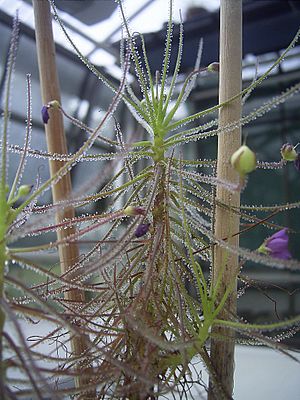Byblis aquatica facts for kids
Quick facts for kids Byblis aquatica |
|
|---|---|
 |
|
| Conservation status | |
| Scientific classification | |
| Genus: |
Byblis (plant)
|
| Species: |
aquatica
|
The Byblis aquatica is a special kind of carnivorous plant. It's often called a "rainbow plant." This plant catches and eats insects to get the nutrients it needs.
Scientists Allen Lowrie and John Godfrey Conran officially described this plant in 1998. It belongs to a group of plants that live for only one year. These plants are found in northern Australia. The Byblis aquatica grows in wet places, like near water. It has sticky glands on its leaves. These glands help it attract, trap, and digest insects. This helps the plant get extra food from its environment.
Contents
Meet the Byblis aquatica Plant
How the Plant Grows
The Byblis aquatica is an annual plant. This means it lives for about one year. It usually has one main stem that doesn't branch out much. This stem is held up by thin, stringy roots.
The main stem can grow up to 45 centimeters (about 1.5 feet) long. When the plant is young, its stem can stand up straight. But once it gets taller than 5 centimeters, it needs help. It leans on other plants nearby for support. Eventually, the stem might fall over and grow along the ground or on the water. Only the very tip of the plant will keep growing upwards.
Sticky, Trapping Leaves
The leaves of the Byblis aquatica are long and thin, like threads. They are usually 2 to 4 centimeters (about 1 to 1.5 inches) long. When they are young, the leaves are bright green and stand up straight. As they get older, they turn a darker maroon color and droop down.
The entire surface of each leaf is covered with tiny, stalked sticky glands. These glands do two important jobs. First, they attract and trap insects. Second, they help the plant "hold on" to other plants or structures for support.
Beautiful Flowers and Seeds
The Byblis aquatica has pretty flowers. Each flower grows alone at the end of a stem. These flower stems are 1.5 to 3 centimeters long. They look a lot like the plant's leaves. The flowers appear on mature plants, growing from where the leaves meet the stem.
The flowers have five petals and are a deep purple color. They bloom between January and May, which is during the Australian summer. Only a few flowers open at a time.
After a flower is pollinated, it turns into a seed capsule. This capsule is shaped like an egg and is about 3 to 4 millimeters long. When the seed capsule dries out, it cracks open. This releases the seeds. The seeds fall onto the ground or into the water. This is how the plant spreads its seeds, using gravity and water to move them. The seeds are black and have grooves along their length. They are about 1 to 1.3 millimeters long.
Where Byblis aquatica Lives
This plant is found in a very small area of the Northern Territory in Australia. It only grows between the cities of Darwin and Berry Springs. However, it is quite common in this specific region.
The Byblis aquatica likes to grow in sandy soil that gets flooded during certain seasons. It also lives in the shallow edges of freshwater lagoons. In these places, it shares its home with another plant called Byblis liniflora. However, B. liniflora usually prefers drier areas.
How We Learned About This Plant
The Byblis aquatica was first collected by Allen Lowrie in April 1988. For a while, people thought it was just a different type of B. liniflora. They even called it Byblis aff. liniflora "Darwin."
But then, in 1996, a scientist named Barry Meyers-Rice showed that it was a separate species. Another scientist, Jan Flisek, suggested it should be described as a new species. So, in 1998, Allen Lowrie officially described it as Byblis aquatica.




